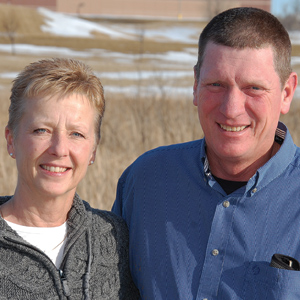Breitkreutzes up their game with covers and grazing
Redwood Falls, Minnesota — Most cash grain growers in the Upper Midwest run big equipment across thousands of acres of GMO corn and soybeans and maybe — just maybe — feed out some of those crops to feedlot cattle or confinement hogs. Often it doesn’t get much more complex than that.
Things aren’t quite that simple at Stoney Creek Farm. Over the past 20 years, Grant and Dawn Breitkreutz have converted a conventional crops and cattle farm into a multi-faceted enterprise that is one part experiment, two parts flexibility, and several parts complex.
Today Grant and Dawn:
• ensure that all 800 of the enterprise’s owned and rented acres — including both permanent pastures and row crop ground — host cattle each year
• employ high-density grazing practices on their permanent pastures
• no-till all of their tillable acreage
• seed cover crop mixes that range up to 14 species
• aim to have 20% of their tillable acreage in extremely complex covers that are grazed by weaned calves and bred heifers from fall into winter
• manage the grazing of those cover mixes to put impressive gains on those animals
• direct market at least 30 grain-finished (non-GMO) beef steers annually
Up next is a move into forage-finishing at least some of their calves, plus the launch of an experiment into using a roller crimper that aims to drastically reduce — and perhaps even eliminate — chemical usage in their no-till management.
Of course all of the above goes far beyond what the great majority of their southwestern Minnesota neighbors are doing. Such management might drive the average corn-and-bean farmer crazy, given all of the ways that Mother Nature can upset one’s best-laid plans for seeding, grazing and such. And the seed budget for cover crops can reach $50 per acre here.
But Grant and Dawn say that the benefits of covers and grazing far outweigh the bother and expense in terms of both current profits and future business sustainability. In the end, one goal underpins all of this complex management: improving soil health. Do that, and they feel profitability and an enjoyable farming life will follow.
Says Grant, “We’re trying to fix our soils as quickly as we can.”
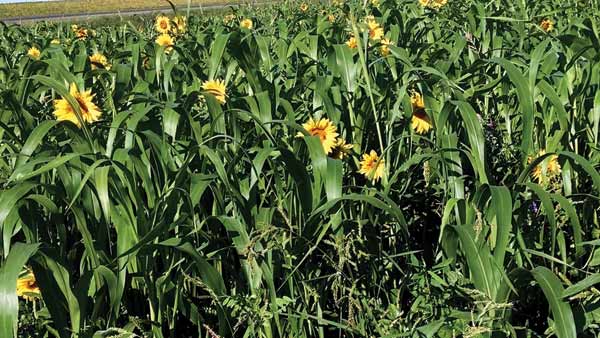
A degraded resource
The soil resource here was degraded by decades of conventional farming practices. Grant and Dawn farm a variety of soil types and topography in the lowlands and on the hills bordering the Minnesota River, which is recognized as one of the Midwest’s most degraded waterways.
By the turn of this century their tillable ground needed high levels of purchased inputs to produce a crop, and their continuously grazed pastures weren’t supporting very many cow-calf pairs.
“I was a corn and soybean growing addict,” he acknowledges.
Their soil health journey started nearly 20 years ago with winter triticale seeded after a corn silage crop had been harvested, although soil health wasn’t the initial reason for that seeding. “At that time we were doing it strictly to produce more forage because we were running out of feed,” Grant explains.
Soon they were noticing excellent weight gains from the harvested triticale. Turnips were seeded after winter wheat, and the cattle were turned out to graze them in the fall.
Grant and Dawn started noticing a couple of things. One is that the cyst nematode problems they had with their other soybean acres were not a factor following the turnips.
And soil structure was improved after these crops. This was all new to them. “I didn’t really know what I was doing,” Grant acknowledges. “But I did start seeing that there is more to this than just providing cattle feed.” For a few years he kept on seeding a few cover crops following cash grain harvests.
Later on he started upping his grazing management on the permanent pastures. This was not an easy task, as many of these pastures are rocky, divided by steep-banked creeks and bounded by barbed wire. But they started using polywire to offer new breaks every day or two, with five- to six-week rest periods in spring and summer and 60 days or more later on in the season. The goal is to have 150,000 lbs./acre of cows and calves in each break in order to ensure adequate trampling and overall animal impact.
Grant and Dawn saw species diversity and yields increasing greatly without fertilizer applications.
Where previously they had set-stocked 58 cow-calf pairs on 137 acres for three months a year, with better grazing and 20 additional acres they’re able to graze 120 pairs for up to seven months without fertilizer.
“High-density grazing fixed a lot of our problems,” Grant says. “We fixed our pasture land, and then we asked ‘why aren’t we doing that with tillable land?’”
Enter complex cover crops
They had started following what Gabe Brown and others were doing with cover crops in their North Dakota cash grain systems. Grant and Dawn decided that if the North Dakotans could be successful with cover crops in such a harsh climate, then they could, too.
They picked up on Gabe’s five steps for improving soil health: eliminate tillage, increase diversity, feed soil life throughout the year, add multi-species covers, and integrate livestock into the cropping system.
Ten years later, tillage has been eliminated on all 360 tillable acres, and each year cover crops are being seeded on all of those acres.
Some of this is pretty simple. Grant will seed cereal rye following corn, soybeans or wheat. In providing fall grazing and soil health benefits, “Cereal rye can do a lot of things,” he says. He has started harvesting some of that rye for seed.
Moving up the complexity scale, a half-dozen or more cover species might be seeded into standing corn planted in 30-inch rows. Grant modified his planter to allow two rows of cover seeds to be planted between each corn row, and has had good catches when the corn has been up to a couple of feet high.
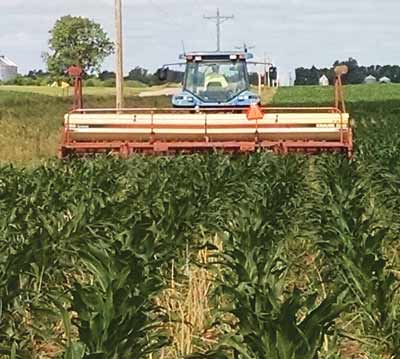
This offers excellent grazing and soil health benefits after the corn has been taken off as either silage or grain. Any covers that survive the winter are terminated when the cash crop is planted the following spring.
What happens and where it happens is where the need for flexibility comes in. Grant would prefer to interseed all of his corn acres, but time constraints and weather conditions prevent that from happening. So instead he’ll need to plant the cereal rye after the corn is off.
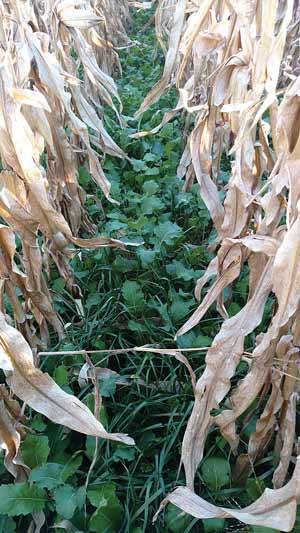
Managing for covers
The covers are so important here that Grant and Dawn have moved to shorter maturity (90-day and RM 1.3) corn and soybeans to give the cover crops more days to grow.
Grant believes covers are worth the money and effort even if an early frost nips the crops and reduces forage mass. “The crops are putting down roots, and what they’re adding to the soil will be valuable next year.”
Last year they upped their game to a 14-species cover mix following an early harvest of oats, peas and barley. This was targeted to the 15% of their tillable acres that needed the most help. Grant says Prairie Creek Seeds provides a mix based on specific resource needs, such as adding carbon to the soil and providing pollinator habitat.
They liked what they saw well enough to commit to putting 20% of their tillable acres into the program. They plan on going to 15 or more species in the cover mix. Here is the 14-species cover crop mix the Breitkreutzes seeded in 2017: Iron and clay cowpea, sorghum sudangrass, hairy vetch, lentil, millet, sunn hemp, medium red clover, Barkant turnip, Ethiopian cabbage, Hunter brassica, Barsica rape, tillage radish, peredovik sunflower, and winfred brassica.
Says Dawn, “We will move these areas around to where we see the need.”
While this is still evolving, they’ve developed a system based on this point of view: “The later we get into the season, the fewer issues we are trying to fix,” Grant explains. If they can seed the complex mixes in June, Grant and Dawn are willing to spend up to $50 per acre on cover seeds. If the seeding can’t happen until August, the ceiling is $25. When circumstances dictate later planting, the limit goes down to $15/acre.
In addition to targeting fields that need some soil health help, decisions for planting the multi-species covers depend upon where the spring-born calves are going to be weaned. Dawn and Grant are committed to fenceline weaning of the calves that are being retained, with the only question being what fence they’ll use.
Last fall they put the cows into their cattle yard and the calves, plus some bred heifers, into the adjacent 14-species cover mix, where they grazed on one-day breaks into February. This year they’re planning on moving to an area where a five-wire electric fence will do the separating.
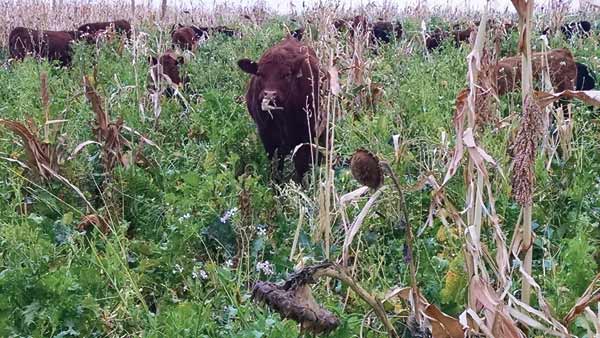
While the cows are noisy, “the calves don’t look back,” Grant says. They also don’t seem to need any medications. Some of the plants turn brown at first frost, but trials off fall and early-winter cover crop grazing have shown daily gains of 2.4 and 2.6 lbs. for weaned calves, and 3.2 lbs. for bred heifers. Grant says the frost-damaged portions of the cover mix balance the greener plants and allow calves to do well without hay through much of the winter.
Dry cows eventually go out to graze corn and wheat stubble with cover crops, and the calves end up in the 200-head cattle yard where some custom finishing is also done. Grant says the nutrient density of the homegrown non-GMO grain is increasing, with corn testing at 9% protein. He thinks his corn can reach 12% protein as soil health improves.
But starting with this year’s crop, some of his calves are going to be finished without grain.
Selling beef
Grant and Dawn have built a pretty good direct-sales business, and now market between 30 and 50 head of grain-finished cattle annually in a territory that ranges from the Twin Cities of Minnesota to Sioux Falls, South Dakota. They’ve been able to do this by offering only bulk beef in quarters, halves and wholes. Non-GMO and “knowing where it was raised” are prime selling points.
Soon they’ll be offering a grassfed option, with steers finishing on cover crops. Says Grant: “Our goal is to offer our customers both grassfed and non-GMO grain-fed beef, with grain being fed to the animals that don’t have the body type for forage finishing.”
Most of the cow herd is commercial Red Angus averaging just over 1,000 lbs. body weight, and the grain-fed steers usually finish at around 1,300 lbs. Grant thinks that by finishing on the complex covers, his smaller-framed steers can consistently reach USDA Choice. He sees plenty of opportunity to expand markets, especially if they added bundled beef to their offerings. They are excited about the USDA-inspected slaughter facility that is coming to their area.
“We need to find additional tillable acres for covers and finishing cattle,” Grant says. Plans are also in the works for “stacking” enterprises like pasture-raised pigs and chickens.
And while there are no plans to certify organic, they are taking steps to remove as many chemicals as possible from their no-till management. This year Grant and Dawn will be running roller crimper trials on their cereal rye to establish best-management practices for interseeding covers without needing to kill the crop.
“Our goal is to get there,” Grant asserts.
Why don’t Grant and Dawn move more of their land into permanent pasture? Grant says it’s easier for the calves to graze covers through deep snow, and that “it’s nice to be able to market several different crops and classes of livestock.”
“My cost of production for corn is so low that it’s profitable, and the same is true with soybeans,” Grant adds. “The small grains are actually my most profitable crops.
“We feel like the cover crops are key to our operation. We know that if we have successful cover crops, we have successful grain crops.” Grant says his corn yields are at or above the county average even with planting short-season varieties and adding a small fraction of the commercial fertilizer (some starter and side-dressed N) used by his neighbors.
They’ve made their share of mistakes and face plenty of challenges. Seedings were lost to herbicide residual in the early years. Finding the time to do the seeding is always a challenge.
Perhaps the biggest ongoing mistake: “not getting the covers in immediately after the grain harvest,” Grant says. This has become a major priority. For instance, last year a cover planting was taking place at the same time the combine was harvesting soybeans in that field.
“It’s a mindset,” Grant explains. “If you want cover crops to work, and you decide they’re going to work, they will work.”
Having an effect
And the soils here are improving. Grant soil tests each year using the PLFA analysis from Ward Laboratories. Over the past 10 years, soil organic matter readings have doubled, to around 4% on most of the soils. Water infiltration rates have increased substantially, and runoff is now minimal even with intense rainfall events.
One mission is to convince others of the merits of what they’re doing. Last year they paid Dr. Allen Williams to speak at a field day on their farm. As part of that event, Grant dug a soil pit to show what was happening in their soils. It was only after he had finished that he realized the pit had been dug in an area where a road rebuilding project done a decade earlier had stripped all of the topsoil and deposited a layer of gravel.
Relates Grant, “I was horrified. I thought this was going to be the worst soil pit anyone had ever seen.” What he saw instead was several inches of new rich, dark soil built up by 10 years of cover crops. That phenomenon was shown in the photo on page 13 of the January 2018 edition of Graze.
Restoring the resource
For Grant, this provided further evidence of what is possible with cover crops and grazing. “My goal is to get our soils back to where the native ground was,” he explains.
Adds Dawn: “We want to leave the soil and the farm in better condition that when we started here. And we’re seeing that we’re doing that.”

